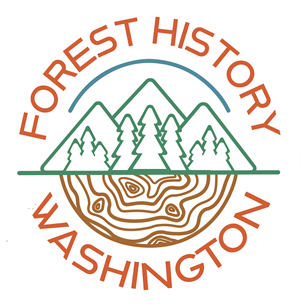On June 21, 1941, the Weyerhaeuser Timber Company dedicates the nation's first tree farm near Montesano in Grays Harbor County. The 120,000-acre tract is named after local logger Charles H. Clemons and had already been harvested and burned over. By the end of the twentieth century, there will be more than 70,000 tree farms in the U.S. comprising more than 93 million acres of land.
Trees Everywhere
When Euro-Americans first arrived in Western Washington, trees were both a barrier to settlement and a source of income. Timber was harvested as fast as it could be cut, moved, and sold. The cleared land became farms and cities. Landowners still paid property taxes so there was an incentive to sell off the real estate with no effort at reforestation. By the 1930s, tax laws changed somewhat and Weyerhaeuser, the nation's largest private landowner, began retaining land with a view to harvesting second-growth trees every 100 years. In 1934, as part of the New Deal, Congress passed the Lumber Code requiring the forest products industry to prepare plans to restore logged lands. Weyerhaeuser loggers left seed trees standing to naturally populate the new forests. In 1937, the company launched a public relations campaign, "Timber is a CROP!" (Sensel, 65).
In 1938, Weyerhaeuser started a seedling nursery at Snoqualmie Falls with a view to replanting the tiny trees. This flew in the face of economic reality since the cost of reforestation was $12 to $15 an acres against the tax sale purchase of timber for $4 an acre.
Foresters found 120,000 acres of harvested land where fire had prevented marketable species from recovering. The property was a mix of private and state-owned land and, as with the practice in forest fire prevention and suppression, the state and the timber company cooperated. The foresters called their project Operation Rehab. Later, the tree farm was named after Charles L. Clemons.
Governor Arthur Langlie (1900-1966) attended the dedication and hoped that Clemons "may set the pace for millions of acres of such lands throughout the state" (Sensel, 124). At first, seedlings were planted by hand. Then foresters tried aerial seeding, which was cheaper, but the forest grew unevenly. Eventually, hand planting became the preferred method.

